Celtic mythology, a profound tapestry of tales and legends, has long been a cornerstone of cultural history in regions like Ireland, Scotland, and Wales. Among its pantheon of deities and heroes, Manannán mac Lir stands out as a pivotal figure. Revered as the God of the Sea, Manannán is not just a guardian of the ocean’s mysteries but also a symbol of the otherworld, embodying themes of magic, protection, and the elusive boundary between the earthly and the ethereal. His origins, rooted in ancient Celtic beliefs, extend beyond mere myth; they are reflective of the Celtic people’s deep connection with nature and their understanding of life’s transient yet cyclical nature. Manannán mac Lir’s enduring significance in Celtic mythology highlights the rich spiritual and cultural fabric of the ancient Celts, weaving a narrative that continues to enchant and educate us about our shared past.
| Attribute | Manannán mac Lir Information |
|---|---|
| Origin | Irish Mythology |
| Deity Type | God of the Sea, the Otherworld, and Protection |
| Role | God associated with the sea, navigation, the Otherworld, and protection of the land |
| Magical Items | Known for possessing magical items like the sword Fragarach and the cloak of invisibility |
| Sea God | Revered as a sea god and guardian of the Otherworld |
| Cultural Impact | A central figure in Irish mythology, symbolizing the mysteries of the sea and the Otherworld |
| Depictions | Featured in Irish folklore and myths, often as a powerful and enigmatic deity |
1. Historical and Mythological Origins
The Historical Context of Celtic Mythology
Celtic mythology, emerging from the mists of pre-Christian Europe, offers a window into the spiritual and cultural ethos of ancient Celtic societies. This mythos, predominantly oral in tradition, played a crucial role in shaping the beliefs and customs of Celtic communities across Ireland, Scotland, Wales, and beyond. The Celts’ reverence for natural elements and their pantheistic beliefs are evident in their myths, which often intertwine nature with divine entities. The historical context of these myths, passed down through generations, reflects a society deeply attuned to the natural world and the cycles of life and death.
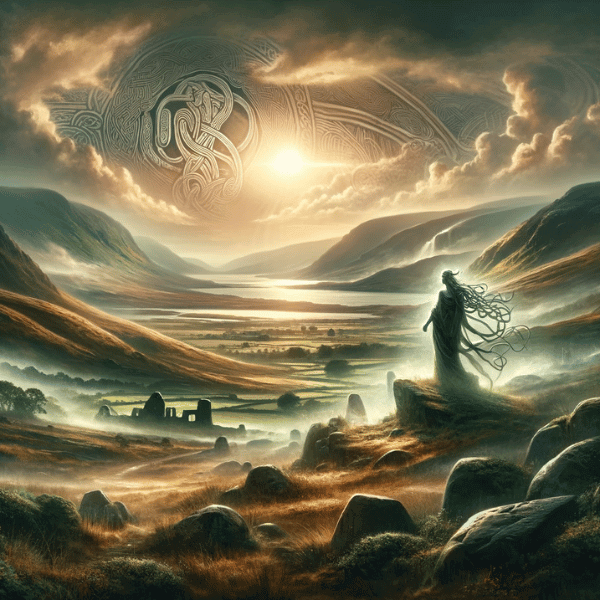
Manannán mac Lir: The God of Sea and Protector
Manannán mac Lir, whose name is etymologically linked to the Isle of Man, emerges from this rich mythological tapestry. Ancient texts like the “Lebor Gabála Érenn” and the “Ulster Cycle” portray him as a formidable deity, ruling over the sea and the otherworldly realms. Manannán often wields a wise and powerful presence, holding magical items such as his invincible sword, Fragarach, and piloting a boat, Scuabtuinne, that requires no oars. His origin story, steeped in the Celtic belief in the sea as a potent and mystical force, positions Manannán not only as a revered god but also as a symbol of guidance and protection for the Celts.
Comparative Mythology
Intriguingly, Manannán mac Lir shares similarities with sea deities from other mythologies. For instance, Poseidon from Greek mythology and Njord from Norse mythology also embody the might and capriciousness of the sea. However, Manannán’s role as a bridge between the earthly and the otherworldly sets him apart, highlighting a unique aspect of Celtic spirituality. This comparison underscores a universal theme across various cultures: the sea as a powerful, life-giving, yet unpredictable force, and the reverence for entities believed to have dominion over it.
2. The Powers and Symbolism
Attributes and Powers of the Celtic Sea God
Manannán mac Lir, in Celtic mythology, is not only a guardian of the seas but also a figure of immense magical prowess. He is known for his extraordinary control over the weather, capable of summoning mists to shield the Isle of Man or guide travelers safely through treacherous waters. His possession of magical items further accentuates his power: the aforementioned sword Fragarach, which could pierce any armor; the cloak of invisibility that shrouded him from mortal eyes; and his self-navigating boat, Scuabtuinne. These attributes underscore his role as a protector and guide, a deity who wielded his powers to influence both the physical and mystical realms.
Symbolism: The Sea, Weather, and the Otherworld
Manannán’s deep association with the sea symbolizes the Celts’ reverence for and fear of this vast, unpredictable element. The sea, in their belief, was a liminal space, a boundary between the known world and the mysterious otherworld. Manannán’s control over the weather, particularly mist, is symbolic of this transition – the mist being a metaphor for the veil between reality and the mystical. Furthermore, as a ruler of the otherworld, Manannán mac Lir represents the cycle of life, death, and rebirth, a concept integral to Celtic spirituality. His character embodies the fluidity and interconnectedness of these realms, highlighting the Celt’s understanding of life’s transient nature and the existence of a world beyond the physical.
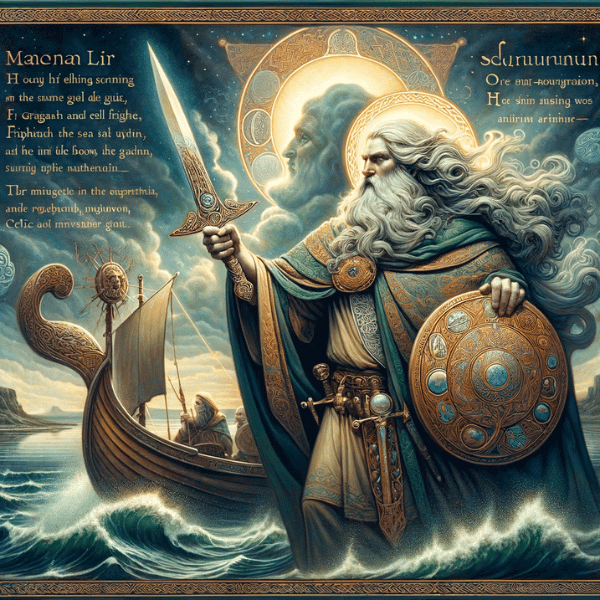
3. Manannán mac Lir in Epic Tales
Epic Stories and Legends Featuring Manannán
Manannán mac Lir’s presence in Celtic mythology is illuminated through various epic tales and legends. In the “Immram Brain” (Voyage of Bran), he is portrayed as a guide, leading Bran to the enchanted Isles of the Blessed. Another significant tale is the “Echtrae Cormaic” (Adventure of Cormac), where Manannán gifts Cormac, the legendary King of Ireland, with magical items, each with profound lessons about life and kingship. In the Ulster Cycle, he is depicted as a foster father and protector of several heroes, imparting wisdom and magical aid. These stories not only showcase Manannán’s role as a deity but also as a moral and spiritual guide, reflecting the values and ethics of the Celtic world.
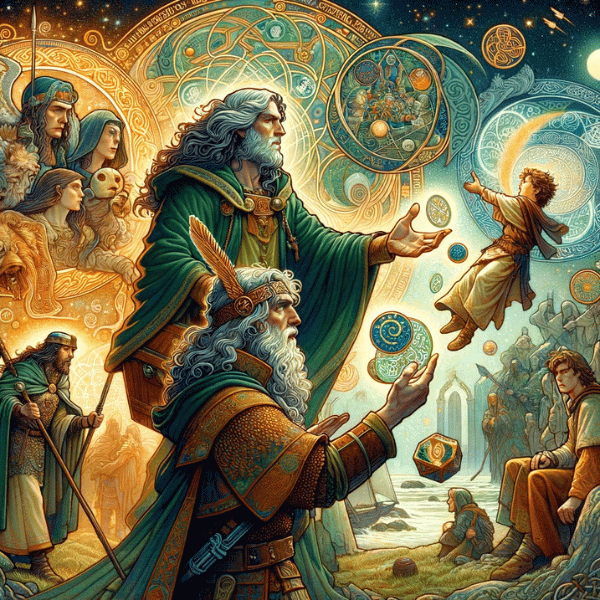
Artifacts Depicting Manannán
Manannán mac Lir’s influence extends beyond tales and into cultural artifacts. The Celtic period features various sculptures, manuscripts, and metalwork displaying symbols and motifs associated with him, like waves, boats, and tridents, despite the rarity of direct depictions due to the iconoclastic nature of Celtic art. The famous “Manannán Statue” in the Isle of Man, although a modern creation, is a testament to his enduring legacy. Manuscripts like the “Book of Lismore” and “Book of Leinster” contain illustrated tales featuring Manannán, offering a visual glimpse into how the ancient Celts might have conceptualized their deities. These artifacts not only serve as historical evidence of Celtic craftsmanship but also as cultural embodiments of Manannán’s significance in Celtic heritage.
4. The Legacy of Manannán mac Lir in Modern Culture
Manannán’s Influence on Contemporary Art
The mystical figure of Manannán mac Lir continues to captivate the imagination in modern times, profoundly influencing contemporary art and literature. Artists often draw inspiration from his enigmatic persona, depicting him in various forms that range from the traditional Celtic style to modern abstract interpretations. In literature, Manannán frequently appears in modern Celtic fiction, portrayed as a wise, sometimes enigmatic character who guides protagonists through trials and adventures. His representation in these works often reflects themes of nature, spirituality, and the deep-seated human connection to the mystical.
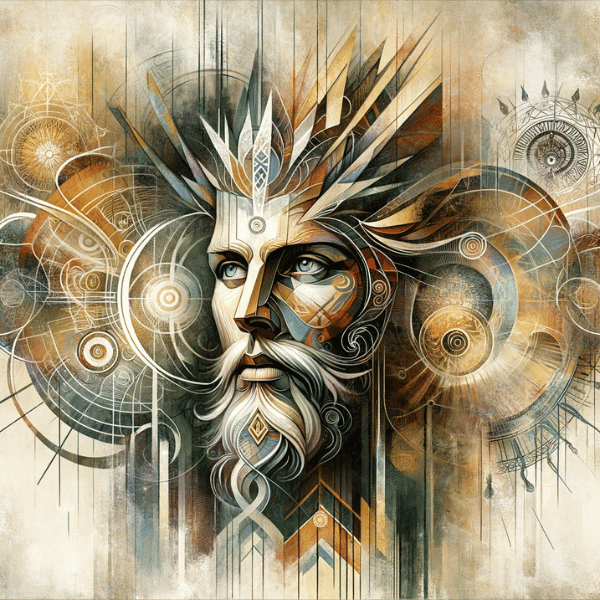
Manannán in Popular Culture
Beyond the realms of art and literature, Manannán mac Lir has made his mark in popular culture as well. He appears in various forms of media, including films, television series, and video games, where his character is adapted to fit contemporary narratives while retaining his core attributes. His influence is also evident in music, with numerous compositions and songs drawing inspiration from his legends. These adaptations not only demonstrate the versatility of Manannán’s character but also highlight the enduring appeal of Celtic mythology in the modern world.
5. Comparative Analysis with Other Sea Deities
Manannán mac Lir and Poseidon
Manannán mac Lir and Poseidon, the Greek god of the sea, offer a compelling comparison. Both rule the oceans and feature prominently in their respective mythologies, but they diverge significantly in persona and symbolism. Poseidon embodies the sea’s chaotic and unpredictable nature, depicted as tempestuous and vengeful, while Manannán symbolizes its mystical and protective qualities, portraying a guardian and guide. This contrast reflects the differing perceptions of the sea in Celtic and Greek cultures – as a mysterious, otherworldly realm in the former, and a formidable, sometimes wrathful force in the latter.
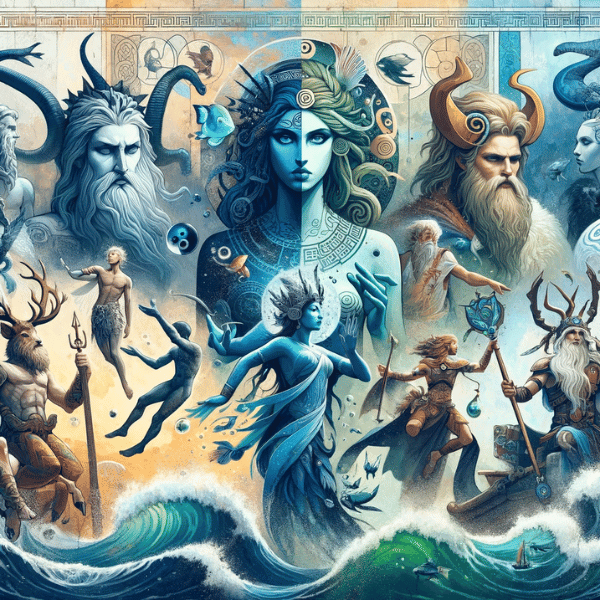
Manannán and Njord: A Norse Comparison
Njord, the Norse god of the sea, is another interesting parallel to Manannán. Like Manannán, Njord is associated with aspects of seafaring and wealth from the ocean. However, Njord’s portrayal in Norse mythology is more focused on the sea’s role in trade and wealth, less on its mystical aspects. This difference highlights the Norse culture’s emphasis on seafaring as a means of livelihood and exploration, in contrast to the Celtic view of the sea as a gateway to the otherworld and a source of spiritual guidance.
6. Conclusion
Manannán mac Lir, the enigmatic Celtic God of the Sea, stands as a testament to the rich and profound lore of Celtic mythology. His depiction as a guardian of the mystical and a guide between worlds captures the Celts’ deep reverence for nature and the unseen. The exploration of Manannán’s origins, powers, cultural significance, and his enduring legacy in modern times provides invaluable insights into the Celtic worldview—a perspective where the natural and supernatural intertwine seamlessly. Studying such ancient deities not only enriches our understanding of past cultures but also offers a mirror to reflect on our own beliefs and values. Manannán mac Lir, with his multifaceted persona, continues to fascinate and inspire, reminding us of the enduring power of myth and its ability to transcend time and cultural boundaries.
